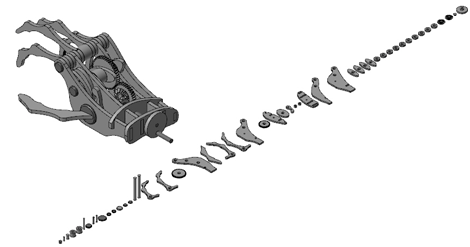
The Solid Disassembly feature can reorientate and lay out all the part bodies in an assembly onto a single plane
The latest version of Mastercam – X9 – has been fully revealed, offering a swathe of upgrades and improvements for its machining capabilities.
A new Multiaxis Link toolpath allows users to link multiple toolpaths together to create a safe linking move between them and can be used for any combination of 3-5 axis toolpaths.
With the growth of multi-tasking machines over the last several years, this alone, with Mastercam X9 Mill-Turn, should help users get the most from those machines.
Elsewhere, the Solid Disassembly feature can reorientate and lay out all the part bodies in an assembly onto a single plane, ready for you to choose which you want to program.
It works on models with and without history, imported from other systems, or created from within Mastercam.
The new Solid Position function allows the user to pick a face of a solid body and mate it to a face of another solid body with a click. The function should also allow users to redefine the base position of the body being moved, then also redefine the final position on the body it is moved to. Letting a user move or copy a solid while positioning.
Model preparation with toolpath associativity has been improved in X9, meaning that now when bodies are edited, only the toolpaths directly affected by the change in the solid body are marked dirty.
The newest interaction of the bounding box function in X9 takes advantage of Mastercam’s push-pull technology. This gives users hands-on access to adjust the size of the bounding box by pushing and pulling on one face at a time, which creates new named planes with options for origin location.
Users can also make incremental changes to the bounding box or to control the actual overall size depending on their need at the time.
An addition called Dynamic Xform promises that users can switch between gnomon manipulation and geometry manipulation mode at any time. Being able to use your original geometry selection to switch back and forth, which should speed up an Xform workflow.
Mastercam can now draw temporary points at AutoCursor positions to define a vector and the midpoint of that vector. These temporary positions remain as long as the same function is active until it is used or replaced by other positions.
Another of the standout features at launch is the preview for Xform Solids, where users will now see the outlined edges of the entire solid rather than simply the bounding box, which should support all entity types, including polygon meshes.






